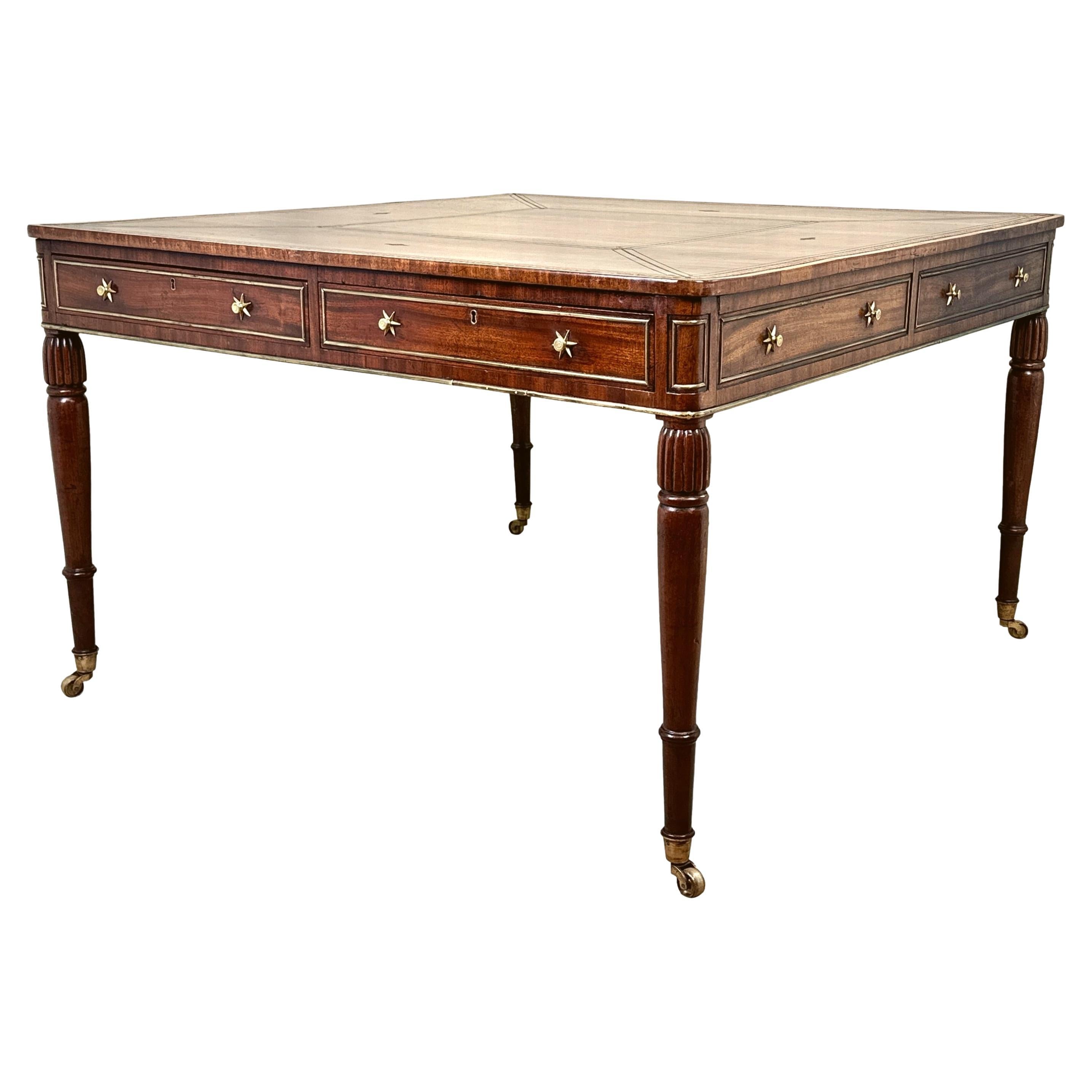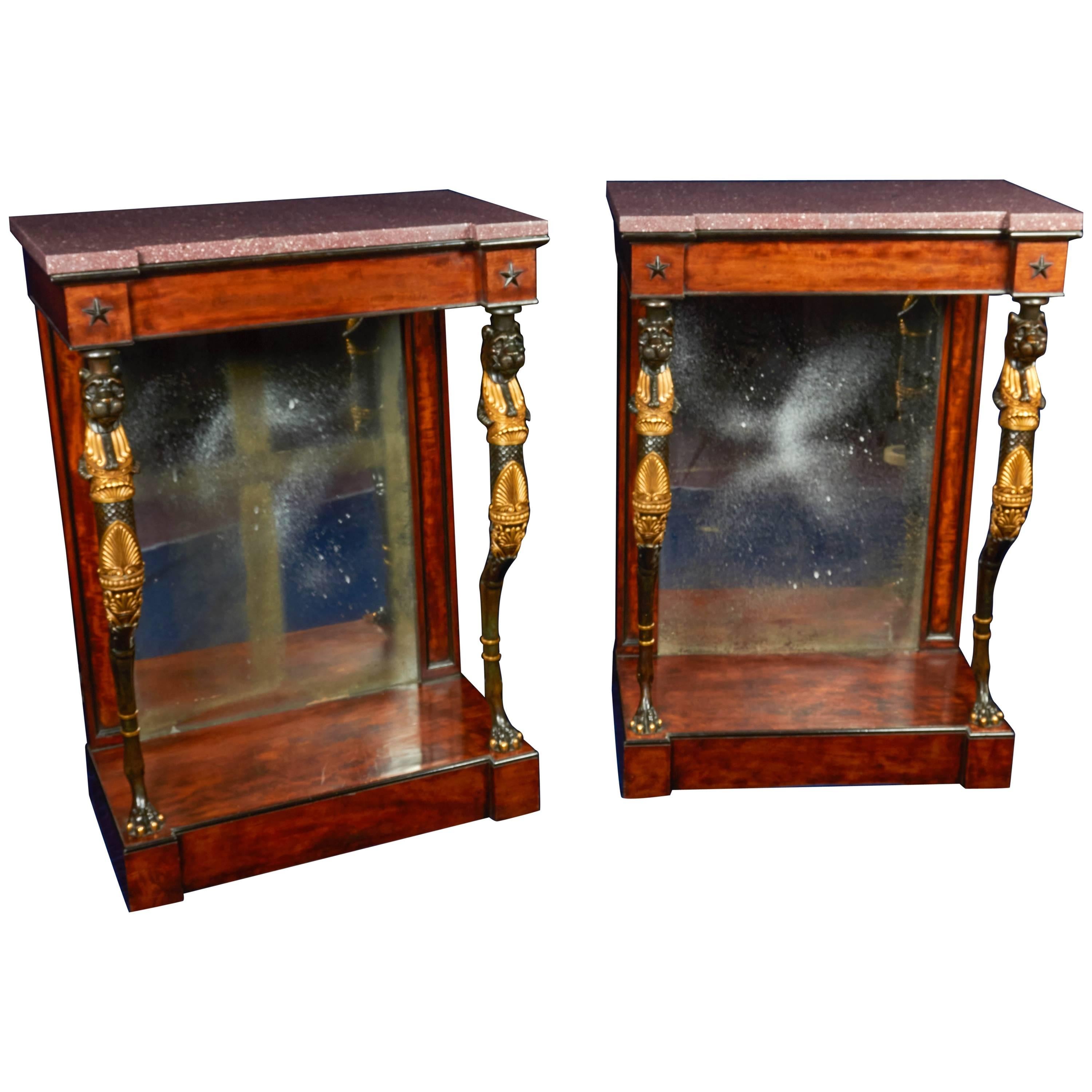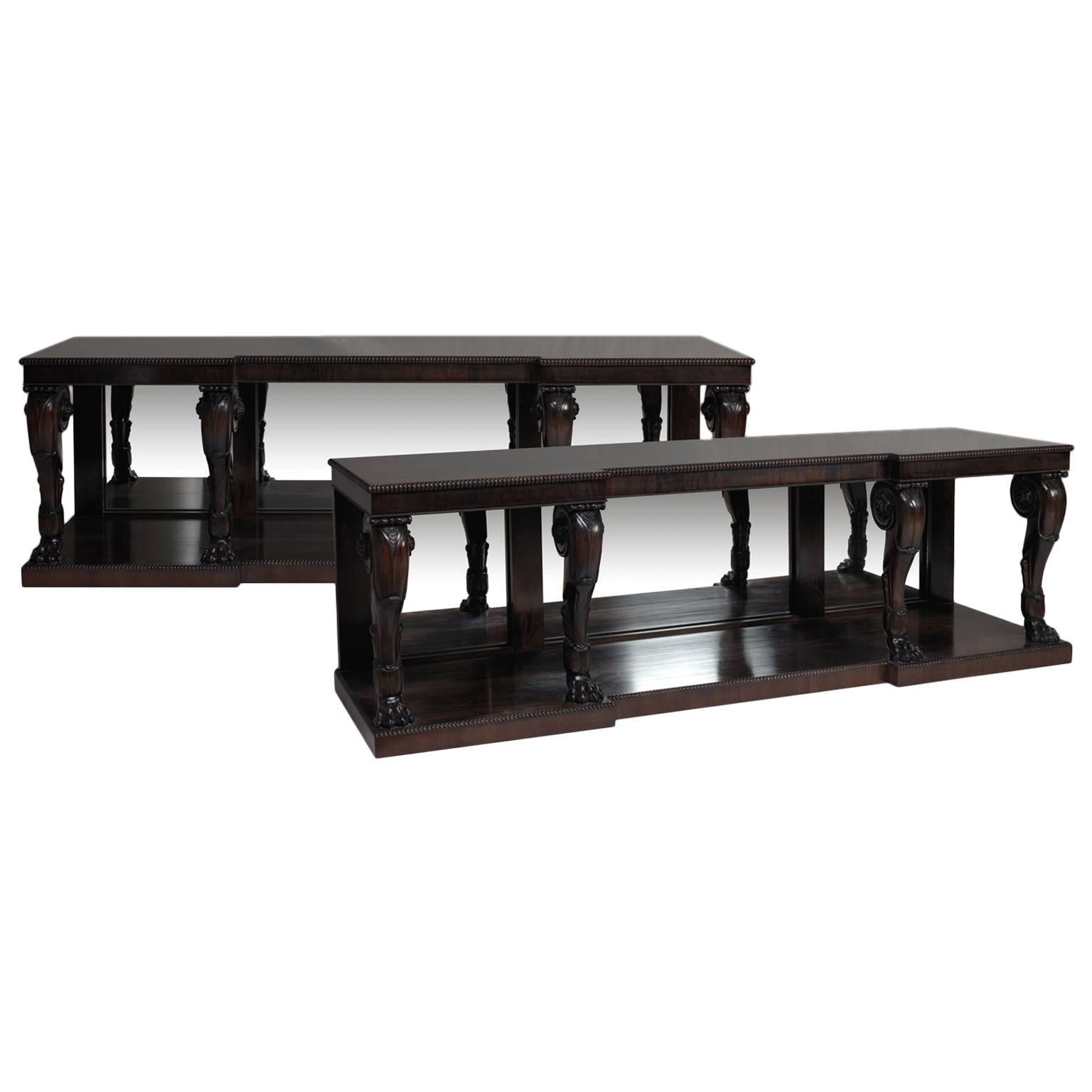Items Similar to Important Regency Mahogany Partners Writing Table in the Manner of George Smith
Want more images or videos?
Request additional images or videos from the seller
1 of 11
Important Regency Mahogany Partners Writing Table in the Manner of George Smith
About the Item
A highly Important, Early Regency period mahogany, ebonised and parcel-gilt partners writing table on monopodia legs of exceptional quality and design, in the manner of George Smith, stamped Chas Norman, whom was associated with the work of Gillows.
Labelled ‘Morning Room’.
English, Regency period, circa 1810.
Rarely seen, the crescent shaped ended rectangular top, beautifully lined with the original gilt tooled leather writing surface, enclosed by a mahogany cross-banded border and reeded edge.
The frieze, containing four finely chosen fiddle-back mahogany drawers, two pairs to opposing sides, each retaining the original gadrooned carved ebonised knob handles. The perimeters having a finely ebonised cockbead, whilst the drawer liners being executed in mahogany retain the original recessed brass locks, which look to have never been removed. Flanking the drawers are bead-moulded ebonised panels which conform to either end above a reeded mould.
Raised on four boldly designed and imposing, crisply carved, ebonised and parcel-gilt leopard monopodia supports, of wonderful original waxed condition. The Egyptian leopards mask above a bold breast decorated with carved gilt anthemion and guilloche motifs, finishing on a finely detailed carved leg and paw foot.
The condition is excellent, retaining the original hand-dyed and gilt tooled waxed leather writing surface along with original locks, handles and ebonising with gilt-work to the legs. Commissioned for what presumes to be a private collection and due to its condition, being obvious to see, this writing table has been home to an important household. Labelled ‘Morning Library’ to the underside, whilst in this exemplary condition strongly suggests this striking piece of Regency furniture has furnished the library of the said house for the majority of its life.
As can be noted, this is an extremely rare, elegant, early Regency writing table of exceptional colour, which corresponds with designs of the celebrated furniture maker and designer George Smith, workmanship of Gillows, being stamped to the underside Chas Norman four times.
George Smith (1756 - 1826) was one of the most influential furniture designers of the English Regency Period (1811-1830). Smith, who began his pattern-book in 1804, wrote of ‘the great taste and elegance’ of this design.
In 1808 he published his influential and definitive text on Regency interior Design titled ‘ A Collection of Designs for Household Furniture and Interior Decoration’ and classed himself as ‘Upholder Extraordinary to His Royal Excellency the Prince of Wales’…The Prince Regent.
Smith was inspired in his designs from his earlier career as an Egyptologist, producing drawings incorporating motifs of Leopards heads and paws, Lions, sphinx’s, anthemia, and griffons amongst others.
Charles Heathcote Tatham (1772-1842) published ‘Etchings, Representing the Best Examples of Ancient Ornamental Architecture; Drawn from the Originals in Rome, and Other Parts of Italy During the Years 1794, 1795, and 1796’, in which he illustrated an antique tripod table with similar monopodiae of leopard heads and paws, based on the original in the Vatican.
Thomas Hope (1769-1831) was also another influential figure to Smiths designs. A rich young man, being the eldest of three sons from a family of Dutch bankers, Hope had travelled extensively spending several years in the Middle East and Greece. He published his ‘ancient furniture’ designs in the ‘Household Furniture and Interior Decoration. 1807’, which was an important and influential book throughout the Regency period. George Smith interpreted Thomas Hopes Egyptian and Grecian themes (although the plates are dated 1804-7) into a more practical design with a greater regard for comfort and utility than for archaeological accuracy, which was widely accepted as the turning point in Regency furniture for the affluent gentry.
Literature for Design of Top and Monopodia Leg: The carved monopodiae on the present writing table related closely to Smith's design for a sofa table (plate 83, 1804) and also his design for a library table (plate 87, 1804).
What can be seen in Smiths book is the similarity in design to the legs with embellished anthemion motifs on a lion-monopodia leg.
For a similar table of shape on lion-monopodia legs see Margaret Jourdain, Regency Furniture, London, 1949, p128 , fig. 139 from Lord Huntingfield, Hevening Hall.
In the same book also the monopodia legs of a closely related design to that of a mahogany side table, circa 1810 from the Duke of Richmond, Goodwood House, page 104 fig 89.
A daybed supported by similar monopodia was supplied by Gillows, which is now in the collection of the Victoria and Albert Museum, London is illustrated in Margaret Jourdain, Regency Furniture, London, 1949, p. 99, fig. 77.
Charles Norman and Gillows. Constructed by Charles Norman whom is noted in the ‘Gillows of Lancaster and London 1730-1840’ book by Susan E. Stuart, where is it said ‘Lucy Wood has reported a similar set of chairs to “Edwards Library” pattern (for this design see Plate 198) stamped ‘Chas Norman’ (LL 4180, Letter 6.9.1999). There is, however, no evidence of his apprenticeship or foremanship in Lancaster.” The “Edwards Library” chair was a distinctive pattern introduced by Gillows in 1810 and one which became very popular for them.
Charles Norman is obviously a master cabinet maker with links to Gillows designed furniture, producing items at the same time of conception to the Gillows design book. There is obviously a strong link between both Charles Norman and Gillows, along with the rare shaped top being almost a signature of Gillows, the timbers used on this writing table are of such quality, which Gillows monopolised during this era due to their company importing the timbers themselves.
For reference; a writing table with a very closely related top can be seen in the ‘Gillows of Lancaster and London 1730-1840 book by Susan E. Stuart, page 375, plate 444. It is the view of the Library at Tatton Park which was a highly important commission for Gillows.
For other examples of Gillows attributed writing tables with related shaped top please see….
Christies London, 2 May 2002, Lot 157 sold for £59,750 albeit with lesser reeded legs. Christies London, 6 July 2000, Lot 88 sold for £47,000 with a similar leg to the above.
Litrature for overall design:
For a similar table of overall design having ebonized lion-monopodia legs see Margaret Jourdain, Regency Furniture, London, 1949, p. 78, fig. 181.
This table was subsequently sold by Bonhams, London, fine English Furniture, 7th March 2012, lot 225, £97250.
A late George IV (later in date and oak lined not mahogany) roswood libarary table Christies London 24 March 2004 realised £47,800 whilst Christies note a further closely related Regency table with mahogany-lined drawers was sold from the Coke Colletion, Jenkyn Place, Christie's London, 17 October 1996, lot 57 (£144,500).
A fine Regency parcel-gilt rosewood table in the manner of Gillows offered at Sothebys New York 18 November 2011 sold for $230,500.
Lastly a similar design desk published in Ronald Philips 2016 Catalogue of Fine Antique English Furniture can be viewed on pages 72 & 73, item number 30.
Interestingly, variant designs for lion monopodia’s featured in Charles Heathcote Tatham's Etchings representing fragments of Antique Grecian and Roman Architectural Ornament originally published in 1799, including that for an 'Antique Tripod of oriental alabaster from the collection in the Museum of the Vatican' which features a closely related prototype leg.
As can be seen from the literature, this is a highly important stunning piece, of exceedingly rare design, derived from the most famous designers of the Regency period.
Dimensions:
Width 64 1/2 inches - 164cm
Height 29 inches - 74cm
Depth 34 1/4 inches - 87cm
Height to underside 23 inches - 58.5cm.
- Creator:Charles Norman (Cabinetmaker)
- Attributed to:George Smith (Designer)
- Dimensions:Height: 29.14 in (74 cm)Width: 64.57 in (164 cm)Depth: 34.26 in (87 cm)
- Style:Regency (Of the Period)
- Materials and Techniques:
- Place of Origin:
- Period:
- Date of Manufacture:1810
- Condition:Wear consistent with age and use.
- Seller Location:Benington, GB
- Reference Number:
About the Seller
5.0
Vetted Seller
These experienced sellers undergo a comprehensive evaluation by our team of in-house experts.
Established in 1969
1stDibs seller since 2015
112 sales on 1stDibs
Typical response time: 1 hour
Associations
LAPADA - The Association of Arts & Antiques DealersThe British Antique Dealers' Association
- ShippingRetrieving quote...Ships From: Benington, United Kingdom
- Return PolicyThis item cannot be returned.
More From This SellerView All
- Antique Mahogany Davenport Writing DeskLocated in Benington, HertsThis attractive mahogany Edwardian Davenport / writing desk, circa 1900s has been constructed from quality solid mahogany having a raised back above a fall front moulded edge writing slope with a raised and fielded panelled cupboard door standing on bracket feet. The Davenport's top section has a brass hinged mahogany lift up lid to reveal an original lead lined storage...Category
Antique Early 1900s English Edwardian Desks
MaterialsMahogany
- French 19th Century Gilt-Bronze Mounted Writing Table of Fine QualityLocated in Benington, HertsAn extremely fine 19th century French Louis XV Revival gilt ormolu mounted Kingwood bureau de dame / writing table. French, circa 1870. A very attractive and of the finest qua...Category
Antique 19th Century French Desks and Writing Tables
MaterialsOrmolu
- An Important 18th Century George Iii Satinwood and Sabicu Writing CabinetLocated in Benington, HertsA fine late 18th Century George III Satinwood and sabicu ladies writing cabinet with important provenance. (Possibly by George Simpson) English London made - Circa 1785 Provenance Exhibited by W. R. Harvey in their Old Bond Street showrooms in 1986 and 1987, the piece being chosen to be advertised in Country Life magazine in 1986 and in the Grosvenor House...Category
Antique 1780s English George III Cabinets
MaterialsSatinwood
- Fine 19th Century Gillows Parquetry and Gilt Bronze Kidney Shaped TableBy Gillows of Lancaster & LondonLocated in Benington, HertsAn extremely fine gilt bronze mounted parquetry kidney shaped writing table attributed to Gillows of Lancaster. English Circa 1865 The rosewood lozenge trellis inlaid kidney shape...Category
Antique 1860s English Desks
MaterialsBronze
- Fine 19th Century Mahogany Leather Upholstered Wingback Armchair in the George ILocated in Benington, HertsA well proportioned and substantial late 19th century carved mahogany wing-back armchair in the George II manner upholstered in a tan leather. English circa 1880. A fine quality and well drawn carved mahogany wing chair inspired by William Kent of the early 18th Century. Upholstered in a hand dyed natural leather with a feather cushioned seat, having grand proportions making this a very comfortable reading chair. The shaped sides with scrolled arms being finished with brass stud work, upon a finely carved mahogany base having a central satyr mask surrounded by foliage and ribbons raised on hipped cabriole legs with shell to the knee terminating on ball and claw feet. This impressive antique leather chair...Category
Antique 1880s English George II Armchairs
MaterialsLeather, Mahogany
- Mid-century Walnut Sideboard Enfilade 1960 in the Manner of Vladimir KaganBy Vladimir KaganLocated in Benington, HertsAn Unusual and Rare Mid 20th Century Walnut Sideboard / Enfilade with pyramid doors and drawers. Probably USA - Circa 1960 Of rectangular form with fo...Category
Vintage 1960s American Mid-Century Modern Sideboards
MaterialsWalnut
You May Also Like
- Regency Mahogany & Brass Partners Writing TableLocated in Bedfordshire, GBAn Exceptional Quality Regency Period Mahogany And Brass, Square, Partners Writing Table, Having Attractive Gilt Tooled Leather Top With Crossbanded Edge, Over Four Drawers And Four ...Category
Antique Early 19th Century English Regency Desks and Writing Tables
MaterialsMahogany
- Regency Irish Mahogany Writing Table in the Manner of Williams & Gibton, DublinBy Williams & GibtonLocated in Belfast, IEThis wonderful writing table with a single drawer concealing a sliding leather lined writing surface within a satinwood border. The leather lined top sits within a rosewood crossban...Category
Antique Early 19th Century Irish Regency Desks and Writing Tables
MaterialsMahogany
- Pair of Regency Mahogany or Bronze Console Tables in the Manner of George SmithBy George SmithLocated in New York, NYA very fine and rare pair of Regency part-ebonized mahogany gilt and patinated Bronze Console Tables in the manner of George Smith, early 1800s, circa 1810. Each side table with a Egyptian Porphory top; Each top above a conforming frieze with ebonized molded edges and applied with a star to the corners raised on Egyptian Lion...Category
Antique Early 1800s English Regency Console Tables
MaterialsBronze
- An Important George III Mahogany Writing TableLocated in Hudson, NYThis very fine mahogany writing table made in England in the French taste would have been for only the most current and fashionable people of the time. The table has a serpentine top...Category
Antique Late 18th Century English George III Desks and Writing Tables
MaterialsEbony, Mahogany
- Serving Tables in the manner of George SmithBy George SmithLocated in Sturminster Marshall, DorsetA pair of grand scale Regency design carved mahogany console tables with four Grand Tour inspired legs to the front, the backs inset with mirror panels, all sitting on singular plint...Category
21st Century and Contemporary English Regency Console Tables
MaterialsMahogany
- Regency Mahogany Writing TableLocated in Essex, MARectangular top with inset brown leather over three drawers with wood knobs , the reverse with same configuration all raised on circular tapered legs and casters.Category
Antique Early 19th Century English Regency Desks and Writing Tables
MaterialsMahogany
Recently Viewed
View AllMore Ways To Browse
Highly Important
Important Desk
Pair Of Desks Tables
Writing Book
Three Leg Writing Table
Antique Writing Tables With Drawers
Important Antique Table
Antique Desk Writing Mahogany
Three Drawer Writing Table
Writing Table And Chair
Writing Desk Set
Antique Wood Writing Table
Sofa Desk Table
Partners Writing Desk
Regency Writing Desk
Mahogany Writing Desk English
Regency Desk Antique Furniture
Antique Writing Tables Mahogany





